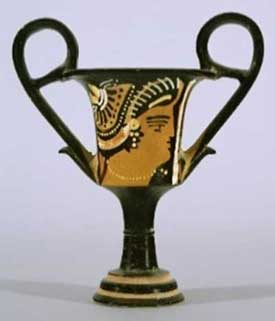

Ingenuity and Stemmed Glassware
George F Manska, CR&D Arsilica, Inc.

As a bartender, you serve many drinks daily in stemmed glassware. Did you ever wonder how stems came to be? Here is a short history that will shed a different light on how stemmed glassware became fashionable throughout Europe, Russia Great Britain and its colonies. In keeping with our topic of sensory evaluation, this article is all about visual esthetics
Human-devised drinking vessels are as old as man himself, with early versions fashioned of cupped hands, folded leaves, coconut shells, animal skulls, seashells, bamboo, carved wood, gourds, animal horns, bark and pitch, or any number of common, natural materials that could hold liquid. There are many online sources regarding the development and evolution of drinking vessels, but glass is the material most commonly in use today, and there is a not-so-apparent reason that stems became popular on wine and spirits glasses.

Short History of Man-Made Glass: Man-made glass was first created in multiple locations; Syria, Mesopotamia, and Egypt, probably around 3600 years BCE in the form of beads fashioned from sodium carbonate. Glassmaking technology flourished in the bronze age, (3300-1200 BCE), and the popular manufacturing method was wrapping a molten, ductile cord of glass around a preformed sand shape. Later on, the glass maker’s preferred shape was tediously ground from a cold hunk or glob of glass into its desired shape.
Manufacturing techniques and formulas for glass were guarded secrets of the ancients, with Syria and Cyprus the origin of colorless glass around the 9th century BCE. Later civilizations saw the drinking vessel as a seriously expressive art form combined with a useful purpose, and style and decoration became an important part of glass manufacturing. Early Egyptians discovered that quartz could be crushed into a fine powder, mixed with plant ash, and cast into ingots for future melting and shaping by experienced artisans.

The Greeks, however, relied on pottery as their drinking vessel material of choice, and these first pieces were shaped as a very wide, shallow bowl with a pedestal base. Many shape-names such as Komast, Krater, and Siana “cups” exhibited bases, along with the first appearance of that connector to the base later called a stem.

In the 13th century AD, Venice, particularly the island of Murano became the center for fine glassware to the royal houses of Europe. Natural crystal pebbles were gathered from two rivers, the Ticino and Adige, and examined for high clarity, free of veins and cracks, and their ability to “spark” when struck. This glass required very high melting temperatures and had to be formed quickly to its desired shape. Peaking in the 15th and 16th centuries, Murano cristallo artisans lengthened pedestals to allow a grip of at least a thumb and two fingers, and maybe a few bumps or ribs to improve grip, resembling the stemmed glassware in use today. Very expensive and cost-prohibitive to the masses, Murano glass was the choice of royal tables throughout Europe and Russia and was the most expensive glass produced anywhere in the world.

What is the function of stems? Imagine large candle-lit halls with long dining room tables able to sit 60-plus guests for dinner. Lighting was by candle, and in addition to large overhead chandeliers, huge candelabras were placed at specific intervals all along the table, as well as mirrors and candle sconces on the walls to brighten the room. Without electric lighting, rooms were dimly lit, and creative ways to improve the lighting from candles were explored in depth. Soon it became apparent that fine wines and spirits could further enhance ambience if stems were taller to catch more candlelight. At the same time, with a little care in handling, greasy fingerprints could be confined to the stem, contributing to the beauty of a filled glass. Murano glass sparkles with tiny rainbows at the edge of each facet when cut and highly polished, as it has a very high index of refraction, prismatically bending light rays to create tiny rainbows and sparkling stars. Stemmed Murano glassware was the sign of a very wealthy household, and successful businessmen and government officials purchased Murano glass to emulate the royals
Leaded crystal was extremely affordable, with little difference in appearance from Venetian glass (to those not so close to the industry). The status-seeking middle and business classes became buyers of affordable leaded crystal, and George Ravenscroft is credited with the invention of Georgian glass which refers to the beautiful, long-stemmed ornately decorated glass popular in the late 17th century to the end of the 18th century, and named for Kings George I, II, and III. Today, in modern lighting conditions, stems still exude a certain elegance, and conveniently still keep fingerprint smears off the bowl, preserving the pristine ruby appearance of a fine vintage claret in a gorgeous vessel at the evening gala.

Leaded glass popularity didn’t last, and many countries have banned its use (including the USA) due to lead poisoning, as lead leaches out of decanters and glassware to find its way into the body causing all sorts of ailments. However, German, and Eastern European glass manufacturers (Riedel, Spiegelau, Schott-Zweissel, Stolzle, Rona, and many others have distinguished themselves with strengthening additives, unique stem-pulling techniques, crystalline glass material, and other improvements to ensure the tradition of the stem continues. Will it ever die? Certainly not in the near future, and some manufacturers offer stems of 12” or more. Impressive to say the least.
In summary, the discoveries of leaded crystal made the coveted stemmed designs preferred by royalty and the wealthy a common, affordable style of glassware for all, cementing the stem as a preferred style among today’s wine and spirits drinkers. At Arsilica Inc, home of the NEAT glass, we love and prioritize science, invention, art, and history in that order, and strive to understand and relate the truths in all. In science, form follows function, invention springs from needs, art is the materialization of the creative mind, and unfortunately, history is usually (re)written by the winners.
Note: Enrolled NEATNEWS subscribers are entitled to 10% discount on all purchases and free
shipping over $55 for as long as you are enrolled. Coupon code: ILUVNEAT
Bio: George F Manska, CR&D, Arsilica, Inc.
Qualifications: Published sensory science researcher, entrepreneur. BSME, NEAT glass co-inventor
Mission: Replace myth and misinformation with scientific truth through consumer education.
Comments Welcome – Contact: george@arsilica.com, phone 702.332.7305.
More Information: www.theneatglass.com/shop

